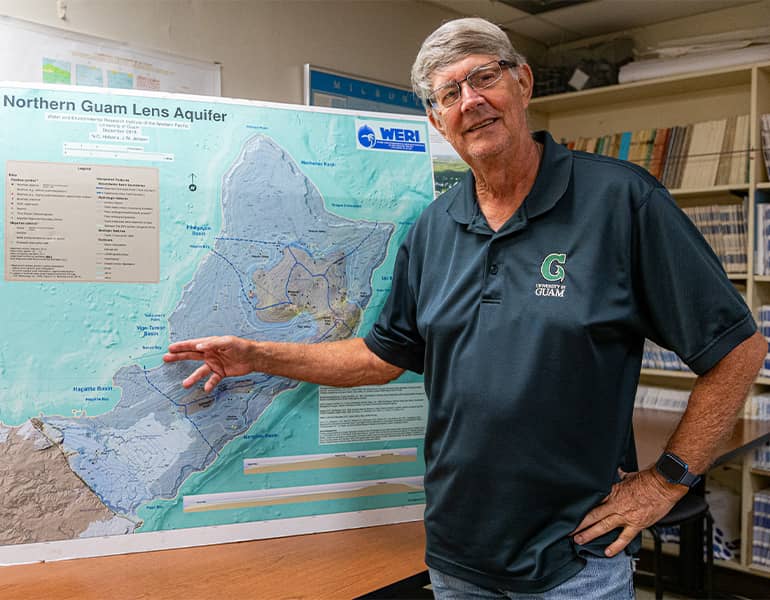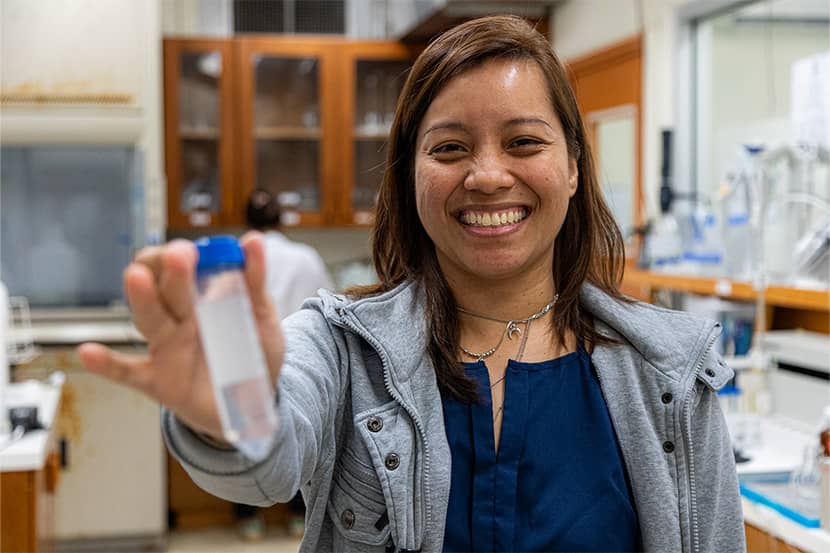WERI lab at UOG worked through devastation to ensure safety of Guam's drinking water
WERI lab at UOG worked through devastation to ensure safety of Guam's drinking water
WERI lab at UOG worked through devastation to ensure safety of Guam's drinking water
7/28/2023
When the all-clear was given after Typhoon Mawar in May, staff and administrators at the Water and Environmental Research Institute of the Western Pacific returned to their building to find that they had no water.
“At that point, we pretty much had to figure out how we were going to operate, because we are a water lab,” Laboratory Manager Mallary Dueñas said. The building’s generator had been down since before the storm.
“This place was dead,” said WERI Interim Director Dr. Ross Miller. There was no way the staff could work. But with islandwide water outages, tests needed to be conducted to make sure drinking water was not contaminated with bacteria.
Dueñas said commercial customers were calling and texting as soon as the storm was over.
At the same time, Guam Environmental Protection Agency representatives contacted the lab and said they needed help with testing supplies. Unlike WERI, Guam EPA had a working generator and running water.
In disaster mode, WERI makes do with makeshift lab
So Dueñas and her coworkers at WERI moved supplies and equipment to the Guam EPA administrative office in Tiyan, creating a makeshift laboratory to ensure the water being provided to island residents was safe to drink.
“When water pump stations are offline, water is not being routinely disinfected and flowing. Bacteria can grow,” she explained. Companies that supply water and ice to customers needed tests to be conducted, “so they needed us up and running at that point.”
Although the WERI lab is certified by the U.S. EPA to perform lead, copper and bacteriological analyses of drinking water, it is not a regulatory body. So the lab had to wait until agencies asked for help.
“This whole storm brought together EPA, Public Health, and then us alongside to help test water sources on Guam and bring some of those water and ice companies back online so that they could start distributing water that is safe,” Dueñas said.
Moving equipment and supplies from the University of Guam Campus in Mangilao to the Guam EPA administration office was another challenge. Laboratory staff hauled all that they could, but UOG’s Plant Maintenance Services had to help move heavier equipment.
Crucial for water testing
The equipment included a machine used to sterilize instruments, which is crucial for water testing. At the EPA office, an old stove was removed from the kitchen to make room for the device. A water bath, used to bring samples to temperature, was also placed in the kitchen.
“This was the first time we were able to be there for another agency and help them get operational,”
Dueñas said. “But while doing that, they granted us access and space, and allowed us to use their instruments so that we can help the public.”
The makeshift lab was crowded, and workers took turns performing tasks.
“We couldn't touch anything until the regulatory agencies were done doing their work. And then once we had space, we had less than two hours to get all the testing done, put it in the instruments and leave,” Dueñas said. “The priority was, of course, the regulatory agencies.”
Miller said typically, the agencies and departments operate separately, but that was not an option after the typhoon.
"Working hand in hand"
“Because everything was so devastated, those boundaries were taken down. And so it was a true temporary merger,” he said. Although the lab still performed testing and not regulation, “we worked hand in hand with those other agencies. Otherwise, we probably still wouldn't be drinking water.”
Miller said the Water Quality Laboratory is self-supporting through income generated by testing. By providing a certified local testing service, the lab allows agencies and companies to save time and money that would be spent sending samples off-island.
WERI has served Guam since 1975, the Federated States of Micronesia since 1991, and the Commonwealth of the Northern Mariana Islands since 1997.
For more information:
To learn more about its mission, go to: https://weri.uog.edu/mission-and-vision/
You can also contact:
Dr. Ross Miller
WERI Interim Director
millerr@triton.uog.edu


